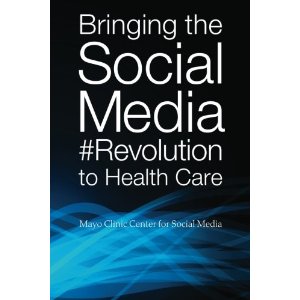 On Wednesday, the Mayo Clinic Center for Social Media introduced Bringing the Social Media Revolution t
On Wednesday, the Mayo Clinic Center for Social Media introduced Bringing the Social Media Revolution t
 On Wednesday, the Mayo Clinic Center for Social Media introduced Bringing the Social Media Revolution to Health Care, a new book to help people, specifically health care professionals, join the conversations taking place on social media – conversations that promote health, support people living with chronic diseases, build bridges, deconstruct silos and improve health care.
On Wednesday, the Mayo Clinic Center for Social Media introduced Bringing the Social Media Revolution to Health Care, a new book to help people, specifically health care professionals, join the conversations taking place on social media – conversations that promote health, support people living with chronic diseases, build bridges, deconstruct silos and improve health care.
The book includes a foreword by John Noseworthy, M.D., President and CEO of Mayo Clinic; Preface by Farris Timimi, M.D., Medical Director of MCCSM; a special section about legal concerns by Mayo Clinic Legal Counsel Dan Goldman, J.D., and a checklist for strategic planning.
But what I particularly like about Bringing the Social Media Revolution to Health Care is that the Mayo Clinic invited 30 social media thought leaders to write personal and personable essays on specific common questions and topics about using social media for health and health care. You’ll be familiar with many of the essay contributors.
I’m proud to have been asked to participate in this book with so many respected social media leaders. I was asked to talk about building community through a Twitter chats. Followers of this blog will know how passionate I am about online community building, so I jumped at the chance. Here’s my essay in full.
Twitter Chats Build Community
A Twitter chat, like many things, is relatively easy to start. See Andrew Spong terrific post on How to host a tweet chat on Twitter including the 35 comments. However, building relationships and sustaining the community requires time and effort. The groundwork for success must be laid before you start.
First ask yourself: Does the world need another healthcare chat? What’s your niche? For #hcsmca (Health Care Social Media Canada), it was a question of local vs. global. Participating regularly in #hcsm and #hcsmeu chats led me to contemplate whether there was an appetite to share locally as an adjunct to the global conversation. As Neil Crump states, “Social chat and the web are global, but regulations, culture, and the way health is paid for create segments of similarity where it makes sense to focus discussion.”
During the summer of 2010 when I was considering starting #hcsmca, I interviewed founders of already existing successful healthcare chats (e.g., #hcsm, #hpm,#nhssm #RNchat, #hcsmeu) to help me understand what I was getting into. I wanted to know:
- What is the workload for the founder of a Twitter chat?
- What were the motivations and goals for each Twitter group?
- What were their best practices?
Today, there are Twitter chats on an amazingly wide range of health-related topics. But if you want to start a new one, first follow chats you like, ask for advice from the founders and build on their examples. Here are the key points I learned:
Start your community before your first chat.
Contact people in your on- and off-line networks to ensure people come to the first chat. Choose people who will set the tone you wish to establish. These founding members can help you determine the optimal time and day for your chat, suggest topics and generate activity and awareness.
Create a home base.
Twitter doesn’t archive well. To capture the community’s history establish a home base. I write community-related articles, introduce or summarize some of the chats and make announcements such as meet-up plans on [this] blog. I use a Google spreadsheet to let participants submit topics and to archive the transcripts.
Continue to make meaningful connections and build relationships.
Get to know participants and potential participants. I reach out to people who may be interested in #hcsmca and who may not have participated before. When a topic is submitted I invite subject matter experts to join the chat. Increasingly, I rely on lists to get to know people.
In Tweetdeck, I have made lists of people who have used the hashtag #hcsmca and people interested in Canadian healthcare who have not used the hashtag. When I see people with common interests, I connect them. If someone has a query that interests the community, I invite them to submit a chat topic.
Collaborating and networking beyond community membership broadens the community’s knowledge and expands access to resources.
Be prepared to commit, but also learn to share the load.
While moderators experience rewards, it takes time and effort to host a weekly chat and maintain relationships beyond the chats. Eileen O’Brien (#socpharm) warned me about this and I took her sage advice and introduced guest moderators from the beginning. Guest moderators expand the network, contribute to the relationship building and bring different perspectives and styles that enrich the community.
Moderating isn’t the only way community members can help. Some may contribute by promoting the community to colleagues or at conferences, announcing upcoming chats regularly, welcoming newcomers during chats or organizing meet-ups. Identify these members and thank them for their support. Recognizing the value of their contribution encourages them to continue and for others to follow suit.
Twitter can help you stay current, expand your network, crowd-source ideas and learn, learn, learn. Chats help filter Twitter for the stuff that’s relevant to you.
![]()






